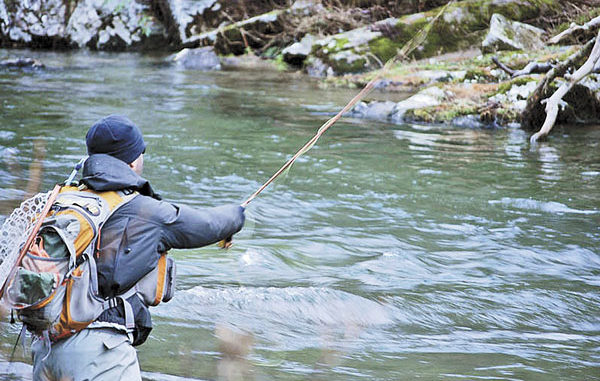
Although spring is undoubtedly the ideal trout time for trout fishing, winter also has its merits. What most winter trout fishers discover is that they catch fewer but larger fish. The downside of winter fishing, particularly during the bitterly cold months of January and February, is that fishing can test an angler’s mettle and patience.The key to successful winter fishing is to use more nymphs and fewer dry flies and fish during the warmest part of the day. Nymph fishing requires much more finesse than topwater, dry-fly fishing, and strikes are more difficult to detect.
“You have to slow your presentation and concentrate on the slower water in the deeper sections of a pool,” said Roger Lowe of Lowe Guide Service in Waynesville. “Nymphs are the best flies to use from now until spring. Dry-fly fishing will be limited to the warmest part of the day, when the sun is on the water,” he said. “The numbers may be fewer, but you’ll find a better quality of fish.”
With fewer hatches coming off, nymphs are the type of food that trout, particularly large trout, see and prefer. When a big nymph floats past a trout, all it sees is one big mouthful of protein. Also, in the winter, brook trout and big brown trout are coming off their fall spawning fasts, and they’re usually hungry and aggressive.
Lowe said he often uses a dry fly such as a Royal Wulff as a strike indicator and a beadhead nymph as a dropper. “The dropper should be small enough so that it doesn’t drag the dry fly down,” he said.
For a No. 16 to 14 nymph, Lowe said, a No. 12 or larger dry fly should be used.
Lowe said he ties a section of leader to the shank of the dry fly so that the dropper dangles about a foot below the top fly.
When using a nymph without a dropper, keep the fly close to the bottom of a pool or run and fish at a slower pace. Strikes will be subtle, sometimes little more than a slight hesitation of the line.
Lowe said he uses bigger nymphs when fishing with a solitary fly: Nos. 10, 8 and even 6.
“I’ll cast a large nymph such as a Woolly Booger across the current.” he said. “When the line straightens out, I lower the rod tip and work the nymph through the water in short strips. It’s important to keep the rod tip down so that the nymph will stay deep.
“Sometimes, you have to keep casting to the same place to get a strike. Keep your presentation slow to give the trout more time to study the fly and respond.”
One technique that many mountain trout fishers use is “dead drifting,” letting the nymph dead-drift to the bottom and stripping it back in short spurts. If you see a trout following the fly but not taking it, freeze. If the trout starts to turn away, give the line a jerk. That will make the trout think that the nymph is trying to escape, and it will usually strike.
Kevin Howell of Davidson River Outfitters near Brevard agrees that the most effective method of nymph fishing is to get the nymph down deep. “Sometimes you have to put the fly right in the trout’s face to get him to hit,” he said.
Howell uses a weighted nymph rather than a beadhead and bumps the nymph along the bottom of a pool.
“Some anglers add weight to the leader, putting lead weight about six inches above the fly for a yo-yo effect,” Howell said. “I prefer to crimp the weight right on top of the fly. That gets it down to the bottom.”
Winter fishing also can be frustrating because trout will suddenly turn off, and nothing you throw to them will get a strike.
“Weather more than anything else dictates the quality of fishing,” Lowe said, “and the time of day when you’re fishing is more important than the pattern you use.”
Once the sun drops below the tree tops, water temperature drops quickly, and trout hunker in to wait out the cold.
Not all winter fishing is limited to nymphs, however. Warm, sunny winter days can produce small but productive hatches of midges and, periodically, Blue-Winged Olives, which can be found on mountain streams almost any time of the year.
Trout generally are more active when water temperatures are in their comfort range: 45 to 65 degrees. They can survive in water temperatures as low as 35, but rarely do mountain streams get that cold. Trout don’t hibernate, nor do they fast. They have to eat to stay alive regardless of the temperature.
One last tip: dress warmly and avoid getting wet.
Winter does have its drab, cold, dreary days, but it also has those beautiful warm, sunny days that make a trout fisher’s heart sing. When those precious days show up, you can bet good money that the trout will be hitting, and you’ll usually have the stream all to yourself.




Be the first to comment